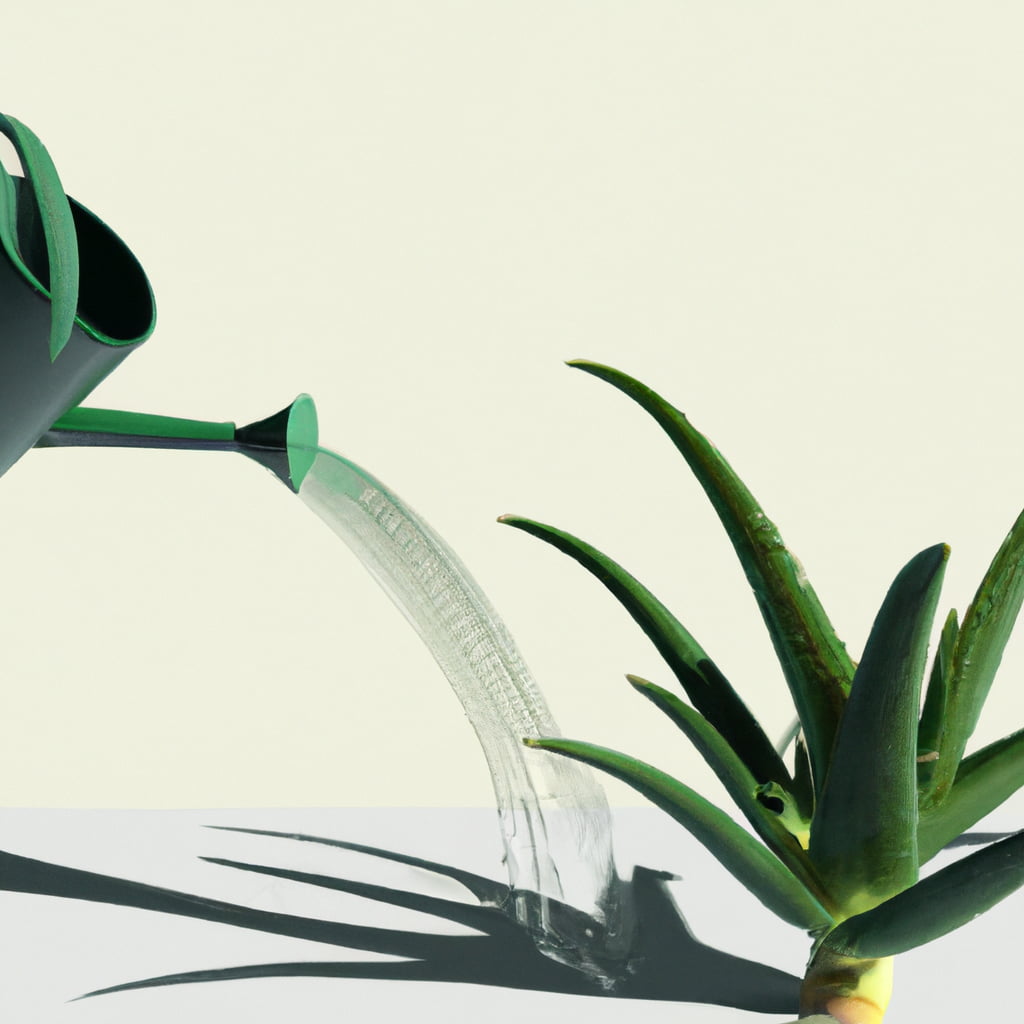Key Takeaway:
- Proper watering is crucial for the health of aloe vera plants: Overwatering or underwatering can lead to root rot and other serious issues that can ultimately kill the plant. It’s important to follow the right techniques and frequency to ensure the healthy growth of the plant.
- Bottom watering is a suitable technique for aloe vera plants: This technique involves pouring water into the tray under the pot to allow the plant to absorb the water through the soil. This method ensures that the roots get enough water and the plant stays hydrated for longer periods.
- It’s important to test the soil moisture and determine the right watering frequency: Aloe vera plants need to be watered when the soil is completely dry, but the frequency of watering may depend on the climate and the surrounding environment. Using distilled or rainwater and avoiding overwatering can also help maintain the overall health of the plant.
Understanding Aloe Vera Plants
If you’re a proud owner of an Aloe Vera plant, you’re likely aware of the importance of proper watering techniques for its survival. In this section, we’ll delve into the topic of understanding Aloe Vera plants, with a focus on the significance of proper watering. Through our exploration, we’ll uncover helpful tips and insights on whether to water aloe vera plants from the top or the bottom.
Importance of Proper Watering for Aloe Vera Plants
Watering Aloe Vera plants correctly is essential for their health. Too much or too little water can cause root rot and wilting. Learn the right watering techniques to prevent these issues!
There are 3 different ways to water: bottom, over soil, and water bath. Remember to measure the soil’s moisture levels often with your finger or a moisture meter. Tap water can contain minerals, so use distilled or rainwater instead. Also, factor in temperature and humidity when deciding when to water.
These tips are key to keeping your Aloe Vera plants healthy. So don’t forget – prioritize proper watering!
Watering Techniques for Aloe Vera Plants
Aloe vera plants are not only easy to care for, but also have a range of health benefits. However, one aspect that can often be confusing for plant owners is how to water their aloe vera plants. In this section, we will explore three different watering techniques, each with its own unique benefits. Join us as we dive into the world of aloe vera plant care and learn how to water your plant like a pro.
Bottom Watering Technique
For Aloe Vera plants to stay healthy, it is important to water them properly. One great way to do this is by using the bottom watering technique. Five steps to follow when doing this are:
- Place a tray or dish under the pot.
- Pour in water until it’s 1 inch high.
- Wait till soil is moist (20-30 minutes).
- Remove any excess water after 30 minutes.
- Do this once a week or when needed.
This method encourages root growth, and makes sure moisture reaches all parts of the plant. Cold tap water should be avoided. Use distilled or rainwater as much as possible. Also, don’t leave stagnant water in trays as it can create an ideal environment for bacteria and fungus to grow.
To further care for your aloe vera, combine the bottom watering technique with the watering over soil technique. With these two methods, your Aloe Vera will stay hydrated, healthy, and thriving.
Watering Over Soil Technique
Caring for your Aloe Vera? Use the right technique when watering! Get your watering can or spray bottle ready with distilled or rainwater. Water the soil until you see it coming out of the drainage holes. Then let the soil dry out a bit before watering again. Don’t leave your Aloe Vera in standing water. Drain off any excess water from the saucer or tray after watering.
Don’t let water splash onto the leaves, as it may cause rotting or fungal infections. Also, don’t use softened or chlorinated tap water, as it contains chemicals that can harm the plant.
To know if it needs water, insert a finger about an inch into the soil’s top layer. If it feels dry, it’s time to water. Then wait for the soil to dry before watering again.
In short: use the watering over soil technique. Apply water to the soil, avoid splashing onto leaves. Use distilled or rainwater, not tap water. Keep your Aloe Vera healthy!
Water Bath Technique
A Water Bath Technique for proper hydration of Aloe Vera Plants. Fill a container with water, wet towels and place them at the bottom. Put the potted plant on top of the towels, ensuring it doesn’t touch the water directly. Let it sit in the bath for 30 minutes. Remove and drain excess water from the pot, then let it dry before returning it to its spot.
Frequently check on your plant and repeat the process when moisture levels drop. But, beware of root rot if you use this technique too often – avoid overusing it.
Tips on How to Avoid Overwatering and Underwatering Aloe Vera Plants
Are you struggling to keep your aloe vera plant healthy? In this section, we will provide you with tips on how to avoid overwatering and underwatering your aloe vera plant. Firstly, we will discuss how to test the soil moisture to ensure your plant is receiving the appropriate amount of water. We will also explain the benefits of using distilled or rainwater for your plant and how to determine the right frequency of watering. With these helpful tips, you can keep your aloe vera plant thriving.
Testing the Soil Moisture
For optimal Aloe Vera plant growth and health, soil moisture must be tested regularly. Proper watering is vital for the plant’s survival. A 5-step guide for testing soil moisture for Aloe Vera includes:
- Put a finger about 1 inch in the soil to check if it’s dry or moist.
- Use a moisture meter to show the water level in the soil.
- Look at the soil color; dark means more moisture.
- Weigh the pot before & after watering to see how much water is being absorbed.
- Use chopsticks or skewers as probes to check moisture levels.
Don’t just rely on one method. Humidity, temperature, and light can all affect the water needs of the plant. Adding organic fertilizers like compost or worm castings helps keep moisture content higher.
A study in ‘The Journal of Alternative and Complementary Medicine’ showed that regular Aloe Vera juice consumption can improve blood sugar regulation in people with type 2 diabetes. Testing the soil moisture is essential for Aloe Vera owners for optimum plant growth and health.
Using Distilled or Rainwater
Ensuring proper hydration of Aloe Vera plants? Crucial. Distilled or rainwater? Perfect! No minerals that can be harmful to the plant.
Table? Great idea! For displaying the benefits of using distilled or rainwater on Aloe Vera plants. Three columns:
| Watering technique | Benefits of using distilled or rainwater | Additional tips |
|---|---|---|
| Bottom watering | Prevents mineral buildup in soil, and water doesn’t touch leaves. | |
| Watering over the soil | Avoid mineral buildup in soil and leaves. But, don’t water too much at once. | |
| Water bath technique | Minimize salt buildup on roots. Fresh water for each soak. |
Still might need to adjust pH level of water. Test it first and make adjustments if necessary.
Pro tip: Collect rainwater in container outside during rainfall. Free, natural water for plants. Plus, conserves resources by reducing reliance on tap water.
Distilled or rainwater? Keep Aloe Vera plants healthy and thriving.
Determine the Right Frequency of Watering
Ensuring the ideal water frequency is key for the growth and health of aloe vera plants. Too much or too little water can be bad, so finding the right frequency is vital.
- Step one to determine this is to test the soil’s moisture levels. A moisture meter or inserting a finger 2 inches into the soil can check dryness. If the soil feels damp, don’t water.
- It’s also important to consider external factors like humidity, temperature, and sunlight. If the environment is hot and dry, more frequent watering might be needed.
- The size of the pot is important for proper drainage and avoiding waterlogging.
- The growth stage of the plant is a factor too. Newly potted aloe vera might need more water than established ones.
- The color of the leaves is also helpful. Green means healthy, while brown or yellowish could mean underwatered.
- Tracking and adjusting the watering schedule is crucial.
- Using distilled or rainwater is better than tap water as it has fewer impurities. This helps the plant better absorb water and stay healthy.
In general, it’s best to water every two weeks after ensuring the soil is dry in between. Consistent watering helps keep your plants looking and feeling vibrant.
Conclusion
Some Facts About Watering Aloe Vera Plants:
- ✅ Aloe vera plants need very little watering, and overwatering can be harmful to them. (Sources: Gardenia Organic, Indoor Plants for Beginners)
- ✅ Watering aloe vera plants from the bottom helps to reach the roots and keep them damp but not soaking wet. (Sources: Gardenia Organic, Planta, Indoor Plants for Beginners)
- ✅ Using filtered or rainwater instead of tap water can help avoid chemical build-up that can harm the plant. (Source: Indoor Plants for Beginners)
- ✅ Proper watering is critical to aloe vera plant health, and there are several ways to water them, including over soil, bottom watering, and water bath. (Sources: Planta, Indoor Plants for Beginners)
- ✅ The Planta app offers personalized care schedules and reminders for watering aloes. (Source: Planta)

A passionate gardener and founder of ForTheLoveOfGardeners.com. She shares her expertise to help you cultivate thriving gardens and find joy in the beauty of nature.
